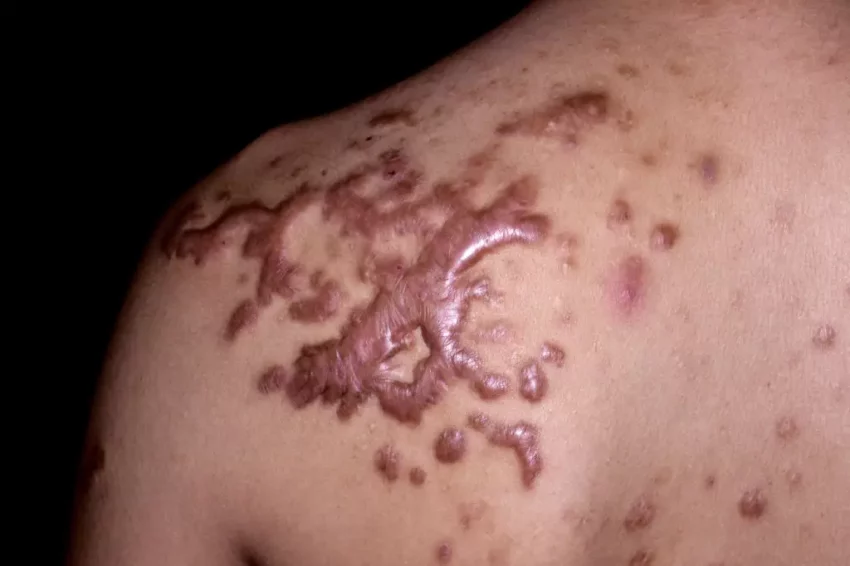Keloids can sometimes lead to complications and infections; however, these are not common. If a keloid grows large and is not maintained correctly, it might lead to skin breakdown, making it susceptible to bacterial infection.
Individuals experiencing this should be careful for increased redness, swelling, and pain. Seeking professional help early is crucial to manage the condition effectively. Speaking of professional service, London’s reliable keloid removal treatments offer comprehensive care for such skin issues, ensuring safety and effectiveness in addressing keloid complications.
What are Keloid Infections?
Keloid infections refer to bacterial invasion in a keloid scar, a raised, thick scar that can develop at the site of a wound. These infections can arise due to skin breakdown over the keloid, providing an entry point for bacteria.
The affected area can become painful, and in some cases, the infection can spread beyond the keloid if not promptly and appropriately addressed. Proper hygiene and care for the keloid and timely medical intervention, when signs of infection appear are crucial to prevent complications.
Common Keloid Scar Infections
Bacterial Infections
Bacterial infections are the most common type associated with keloid scars. Bacteria can infiltrate the scar tissue significantly when the skin’s integrity is compromised. This can lead to redness, swelling, and pus formation. Timely antibiotic treatment is essential to manage bacterial infections effectively.
Fungal Infections
Fungal infections can happen even though they are less frequent, especially in warm, damp conditions. Itching, scaling, and modifications in the color of the keloid scar can all be signs of a fungus infection. Usually, antifungal drugs are used to treat this illness.
Cellulitis
Cellulitis is a specific bacterial infection affecting the skin’s deeper layers. Keloids can sometimes be affected, leading to extensive redness, pain, and warmth around the scar. Early intervention with antibiotics is crucial to prevent the spread of cellulitis.
Impetigo
Impetigo is a contagious skin infection often caused by staph or strep bacteria. If a keloid is infected, it might exhibit sores, blisters, or a honey-colored crust on the surface. Topical or oral antibiotics are used to counter this infection.
Abscess Formation
A pocket of pus, known as an abscess, can sometimes form in and around the keloid due to a bacterial infection. It requires medical attention, where the abscess might be drained and antibiotics prescribed to clear the infection.
Staph Infections
Staphylococcus bacteria can sometimes infiltrate keloid scars, leading to painful, swollen, and warm skin around the area. It often requires a combination of topical and oral antibiotic treatments to manage the infection effectively.
Signs of Keloid Infection to Watch For
- Increased redness around the keloid scar
- Swelling or warmth in the affected area
- Pain or tenderness when touched
- Pus or fluid drainage from the keloid
- A foul odor emanating from the scar
- Fever or chills indicating a systemic infection
- Skin breakdown or ulceration over the keloid
- An increase in the size or elevation of the scar
- Itching or burning sensations around the area
- Development of sores or blisters on or near the keloid
What to do if Keloid Infection is suspected?
Clean the Area
If a keloid infection is suspected, gently clean the affected area with mild soap and water. Avoid scrubbing, as it can exacerbate the issue. Pat the area dry and avoid irritation.
Avoid Self-Treatment
While the urge to self-treat can be strong, avoid applying over-the-counter creams or ointments without professional advice. Incorrect treatments can sometimes worsen the infection.
Seek Medical Attention
It is essential to consult with a doctor promptly. They can diagnose the severity of the infection and prescribe appropriate antibiotics or other treatments to address the issue effectively.
Follow Prescribed Treatments
Adhere to the medication or treatment regimen provided by the doctor. Complete antibiotic courses as prescribed to ensure the infection is entirely eradicated.
Maintain Hygiene
We are keeping the area clean and avoiding any additional irritation or injury to the keloid and surrounding skin aids in the healing process.
Avoid Irritation
Stay away from activities that can irritate the keloid or affected skin area to expedite the healing process and avoid exacerbation of the infection.
Risks & Complications Associated with Keloids
- Keloids can lead to skin infections, with the raised scars becoming red, swollen, and painful due to bacterial infection.
- The formation of keloids near joints or flexible areas can restrict mobility, causing discomfort and limiting movement.
- They often result in skin irritation and sensitivity, exacerbated by friction from clothing or reactions to certain skincare products.
- The appearance of these raised, prominent scars can impact self-esteem and confidence, leading to emotional distress.
- Keloids have a high propensity to reoccur, even after successful treatment, making their management challenging.
- Some individuals experience pain, tenderness, or itching in the area of the keloid, leading to physical discomfort.
How to Prevent Keloid Infection?
- Keep the area clean: Regularly clean the keloid and surrounding skin with mild soap and water.
- Avoid scratching or picking: Refrain from touching or scratching the keloid, as it can introduce bacteria and increase the risk of infection.
- Antibiotic ointment: Apply an antibiotic ointment to the keloid if recommended by a healthcare professional.
- Use sterile dressings: Cover the keloid with a sterile bandage or dressing to protect it from external contaminants.
- Hands hygiene: Always wash your hands thoroughly before touching the keloid or changing dressings.
- Limit sun exposure: Protect the keloid from excessive exposure, which may lead to hyperpigmentation. Use sunscreen or cover the area with clothing.
- Follow aftercare instructions: If the keloid resulted from a surgical procedure, adhere to the post-operative care instructions provided by your surgeon.
- Seek medical attention: If you notice signs of infection, such as increased redness, swelling, pain, or discharge, consult a healthcare professional promptly for appropriate treatment.

